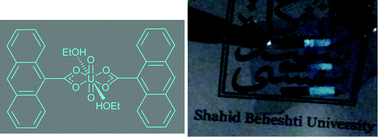Fabrication of blue organic light-emitting diodes from novel uranium complexes: synthesis, characterization, and electroluminescence studies of uranium anthracene-9-carboxylate complexes†
Abstract
In this study, three uranium(VI) complexes, [UO2(C15H9O2)2(CH3CH2OH)2]·2CH3CH2OH (1), [U2O4(C15H9O2)2(CH3O)2(CH3OH)2]·2CH3OH (2), and [U2O4(C15H9O2)4(CH3OH)2]·2H2O (3), were prepared by reacting anthracene-9-carboxylic acid with uranyl acetate dihydrate using various ligand to uranyl acetate ratios in different solvents. The infrared and UV-Vis spectra along with elemental and thermal analyses showed the formation of mono- and dinuclear anthracene-9-carboxylate complexes of uranium. A 1 to 3 molar ratio of uranyl acetate to anthracene-9-carboxylic acid in ethanol resulted in the formation of the mononuclear complex 1, whereas a 1 to 2 and 1 to 3 molar ratio of uranyl acetate to anthracene-9-carboxylic acid in methanol produced the dinuclear complexes 2 and 3, respectively. Single-crystal structure determinations of 1, 2 and 3 revealed hexagonal bipyramidal geometries for the mononuclear uranium complex of 1 and a pentagonal geometry for the dinuclear uranium complexes of 2 and 3. The single-crystal structures of complexes 2 and 3 showed π–π interactions in contrast to complex 1. The strong π–π interactions in complex 2 and 3 lead to an enhanced photoluminescence intensity in comparison with 1 without π–π interaction. The optical properties of the prepared complexes are associated with the ligand-induced resonant system. The fluorescent uranium complex 1 that showed a blue emission upon excitation at 270 nm was used for the fabrication of a blue organic light-emitting diode (BOLED), an industrially important OLED, using a simple solution-process fabrication method.



 Please wait while we load your content...
Please wait while we load your content...